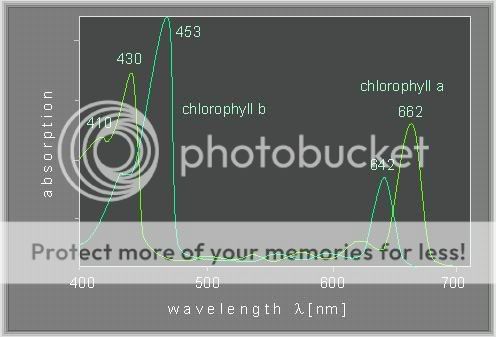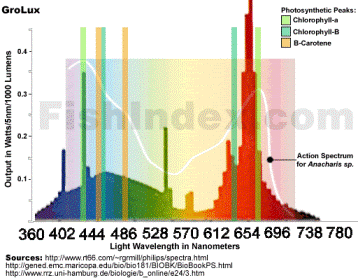I found this post explaining light and the wavelengths which is what i was speaking more of.
The most common mistake people make with planted tanks is to not understand photosynthesis and the visible spectrum of lighting that affects plant growth. Most people choose lighting solely based on the Kelvin temperature of a bulb. This tells you very little about what type of light within the spectrum is being emitted and at what strength. Visible light is on a scale in nanometers (radiated wavelength) from 400nm (violet) to 700nm (red). Simple matter of photosynthesis: plants can only utilize light that is absorbed. Bright light is essential yet only a portion of this white light is used for photosynthesis. The blue and red zones of the visible spectrum are the most beneficial to plants. Green plants appear green because it is reflected light. How "bright" a light appears has more to do with how much light is output in a given area visible to the human eye, with "brightness" being at a maximum in the
green spectrum(middle of visible spectrum, or around 550nm).
Report this image
Lighting for a planted tank should not be chosen on color temp alone. It is true that 'full spectrum' bulbs are referred to as bulbs between 5000 Kelvin (K) and 6500 K and are considered to be best for planted tanks. Yet this does not indicate what wavelength in nanometers the bulb is actually emitting. If you want to optimize plant leaf development (blue light) and stem elongation and color (red light) you need light in both the blue and red spectra for photosynthesis. You need a mix of blue and red for your plants, and green for you (brightness as perceived by humans). If your lighting looks extremely bright and your plants seem ultra-green, it means that you have lighting that outputs strongly in the
green spectrum. Do not equate this with good lighting for your plants, because plants don't use light in the
green spectrumfor photosynthesis. Sunlight peaks in the blue spectrum at 475 nanometers (nm). This is a shorter wavelength than red light and is used by both plants and algae. As light passes through water the intensity decreases. The shorter wavelength blue light penetrates water better and more quickly than red, which is slower and absorbed more quickly. Chlorophyll, the photosynthetic pigment used by plants traps blue and red light but is more efficient with red light at 650 – 675nm. Blue is used at the same rate as red because it is more available for reasons mentioned above.
For green plants the lighting peaks that are most important:
Chlorophyll-a: 430nm/662nm
Chlorophyll-b: 453nm/642nm
Carotenoids: 449nm/475nm
Red pigmented plants use more light in the blue area of the spectrum.
Report this image
Beyond choosing lighting that is optimal for photosynthesis, as above, you should choose lighting with the color temperature that best suits the aesthetic goals of your tank. So, don't obsess about color temperature beyond how you want your tank to look. From a color temperature standpoint, blue-colored light will enhance blues in your fish. Green-colored light will make the tank look bright to humans and enhance the green color of your plants. Red-colored light will enhance the
redsin your fish, and any
red plants.
Lux is lumens/square meter, so they are similar. They are both defined in terms that are meaningful to human perception of light – not plants. They stress the amount of energy in the green band to which humans are most sensitive – not plants.
Artificial light sources are usually evaluated based on their
lumenoutput. Lumenis a measure of flux, or how much light energy a light source emits (per unit time). The
lumenmeasure does not include all the energy the source emits, but just the energy with wavelengths capable of affecting the human eye. Thus the lumenmeasure is defined in such a way as to be weighted by the (bright-adapted) human eye spectral sensitivity.
Report this image








